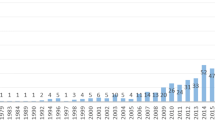Abstract
Europeana is a large-scale search engine for digitised cultural heritage material. It aggregates metadata from various European institutions such as libraries, archives, museums and galleries. The heterogeneous data and the enormous scale (53 million objects in over 50 languages) pose specific challenges for search and exploration. In this paper, we address the different challenges and solutions for information access within Europeana including information needs, data enrichment, ranking and other search aspects for digital cultural heritage.
Similar content being viewed by others
Notes
https://lucene.apache.org/solr/. MongoDB (to effect virtual joins between documents) and Neo4J (for storing the structure of hierarchical objects) are also used.
References
Bearman D, Trant J (2002) Issues in structuring knowledge and services for universal access to online science and culture. Nobel Symp 120:26–29
Bélanger ME (2010) Annotations and the Digital Humanities Research Cycle: Implications for Personal Information Management. In: iConference Proceedings – Posters
Shneiderman B (1996) The Eyes Have It: A Task by Data Type Taxonomy for Information Visualizations. In: IEEE Proceedings of Visual Languages, pp 336–343
Brockman WS, Neumann L, Palmer CL, Tidline TJ (2001) Scholarly Work in the Humanities and the Evolving Information Environment. CLIR – Council on Libary and Information Resources. https://www.clir.org/pubs/reports/pub104/contents.html
Broder A (2002) A taxonomy of web search. Sigir Forum 36(2):3–10
Ceccarelli D, Gordea S, Lucchese C, Nardini FM, Tolomei G (2011) Improving europeana search experience using query logs. In: Research and Advanced Technology for Digital Libraries: International Conference on Theory and Practice of Digital Libraries, TPDL. Springer, Berlin, Heidelberg, pp 384–395
Clough P, Otegi A, Agirre E, Hall M (2013) Implementing recommendations in the paths system. In: International Conference on Theory and Practice of Digital Libraries – Selected Workshops. Springer, Berlin, Heidelberg, pp 169–173
Dobreva M, Chowdhury S (2010) A User-Centric Evaluation of the Europeana Digital Library. The Role of Digital Libraries in a Time of Global Change: 12th International Conference on Asia-Pacific Digital Libraries, ICADL, Gold Coast, Australia, June 21–25, 2010. Springer, Berlin Heidelberg, pp 148–157
Dörk M, Sheelagh C, Williamson C (2011) The Information Flaneur: A Fresh Look at Information Seeking. In: CHI 2011: Proceedings of the SIGCHI Conference on Human Factors in Computing Systems. ACM, New York, pp 1215–1224
Gäde M (2014) Country and language level differences in multilingual digital libraries. Ph.D. thesis, Humboldt-Universität zu Berlin, Berlin (http://d-nb.info/1049982177)
Gäde M, Petras V, Stiller J (2010) Which log for which information? gathering multilingual data from different log file types. In: International Conference of the Cross-Language Evaluation Forum for European Languages, CLEF 2010. Springer, Berlin, Heidelberg, pp 70–81
Goel S, Broder A, Gabrilovich E, Pang B (2010) Anatomy of the long tail: ordinary people with extraordinary tastes. In: Proceedings of the third ACM international conference on Web search and data mining. ACM, New York, pp 201–210
Goodale P, Agirre E, Griffiths J, Fernie K, Stevenson M, Hall M, Clough P (2013) Pathways to discovery: supporting exploration and information use in cultural heritage collections. In: Proceedings of Museum and the Web
Hill T, Charles V, Isaac A, Stiller J (2016) “Searching for Inspiration”: User Needs and Search Architecture in Europeana Collections. In: 2016 Annual Meeting of the Association for Information Science and Technology
Hill T, Isaac A, Charles V, Freire N, Manguinhas H (2016) MS31 report on the improvement of search. Tech. rep.
Király P (2015) A metadata quality assurance framework – project plan. https://pkiraly.github.io/metadata-quality-project-plan.pdf
Liu TY (2009) Learning to rank for information retrieval. Found Trends Inf Retr 3(3):225–331. doi:10.1561/1500000016
Manguinhas H (2016) Europeana Semantic Enrichment Framework. Documentation, Europeana. https://docs.google.com/document/d/1JvjrWMTpMIH7WnuieNqcT0zpJAXUPo6x4uMBj1pEx0Y
Manguinhas H, Freire N, Isaac A, Stiller J, Charles V, Soroa A, Simon R, Alexiev V (2016) Exploring Comparative Evaluation of Semantic Enrichment Tools for Cultural Heritage Metadata. In: International Conference on Theory and Practice of Digital Libraries. Springer, Berlin, Heidelberg, pp 266–278
Olensky M, Stiller J, Dröge E (2012) Poisonous India or the Importance of a Semantic and Multilingual Enrichment Strategy. 6th Research Conference, MTSR, Cádiz, Spain, 2012. Springer, Berlin, pp 252–263
Petras V, Bogers T, Toms E, Hall M, Savoy J, Malak P, Pawłowski A, Ferro N, Masiero I (2013) Cultural heritage in CLEF (CHiC) 2013. Lecture Notes in Computer Science, vol. 8138. Springer, Berlin, Heidelberg
Petras V, Ferro N, Gäde M, Isaac A, Kleineberg M, Masiero I, Nicchio M, Stiller J (2012) Cultural Heritage in CLEF (CHiC) Overview 2012. CLEF 2012 Evaluation Labs and Workshop, Rome, Italy, September 17–20. (http://ceur-ws.org/Vol-1178/CLEF2012wn-CHiC-PetrasEt2012.pdf)
Petras V, Stiller J, Gäde M (2013) Building for Success?: Evaluating Digital Libraries in the Cultural Heritage Domain. In: Cool C, Ng KB (eds) Recent Developments in the Design, Construction, and Evaluation of Digital Libraries: Case Studies. IGI Global, Hershey, pp 141–163
Purday J (2009) Think culture: Europeana.eu from concept to construction. Electron Libr 27(6):919–937
Ruecker S, Radzikowska M, Sinclair S (2011) Visual interface design for digital cultural heritage: A guide to rich-prospect browsing. Ashgate Publishing, Ltd., Brookfield
Stiller J (2014) From curation to collaboration: a framework for interactions in cultural heritage information systems. Ph.D. thesis, Humboldt-Universität zu Berlin, Berlin (http://d-nb.info/1051387302/)
Stiller J (2016) Best practices for multilingual access. Tech. rep. http://pro.europeana.eu/files/Europeana_Professional/Publications/BestPracticesForMultilingualAccess_whitepaper.pdf
Stiller J, Gäde M, Petras V (2010) Ambiguity of Queries and the Challenges for Query Language Detection. In: CLEF 2010 Labs and Workshops Notebook Papers
Stiller J, Gäde M, Petras V (2013) Multilingual access to digital libraries: The Europeana use case. Information-wissenschaft Prax 64:86–95
Stiller J, Petras V, Gäde M, Isaac A (2015) Cultural Analytics – Evaluating Cultural Heritage Information Systems. iConference 2015 Proceedings. http://hdl.handle.net/2142/73788
Tsagkias M, Weerkamp W (2015) What are they looking for? Statistical In-Depth Analysis of Europeana’s Query Logs. Tech. rep.
Whitelaw M (2015) Generous interfaces for digital cultural collections. Digit Humanit Q 9(1) (http://www.digitalhumanities.org/dhq/vol/9/1/000205/000205.html)
Author information
Authors and Affiliations
Corresponding author
Rights and permissions
About this article
Cite this article
Petras, V., Hill, T., Stiller, J. et al. Europeana – a Search Engine for Digitised Cultural Heritage Material. Datenbank Spektrum 17, 41–46 (2017). https://doi.org/10.1007/s13222-016-0238-1
Received:
Accepted:
Published:
Issue Date:
DOI: https://doi.org/10.1007/s13222-016-0238-1




